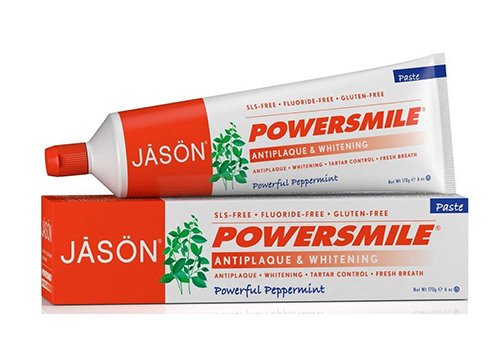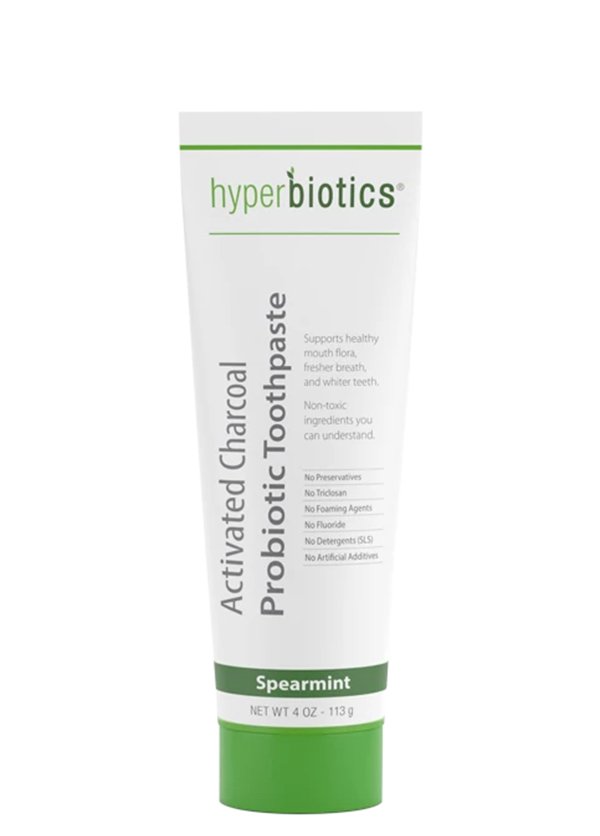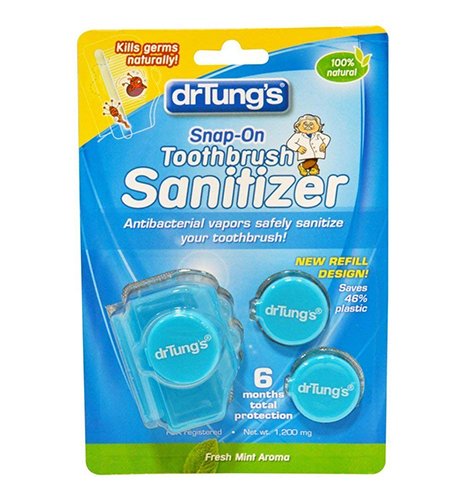Table of Contents[Hide][Show]
From tooth polishes to whitening toothpastes to whitening strips to laser treatments, there are a ton of options to whiten your teeth. But do whitening methods work? Are they safe? What is the best whitening toothpaste?
Contrary to popular cultural thought, no whitening method is a magic bullet solution. In fact, yellowed teeth may reveal an even deeper issue than a cosmetic one.
Even teeth that have been well cared for may not be incredibly white.
We need to start by clarifying what is and is not possible with teeth whitening. Then, I’ll discuss the different types of whitening you can achieve. There are two broad types of tooth discoloration to consider: intrinsic and extrinsic.
But first…What are the best whitening toothpastes in 2020?
The Best Whitening Toothpastes on the Market
Here are my two favorite whitening toothpastes:
Best for Gentle Whitening
Jason Natural Powersmile Whitening Toothpaste
This baking soda-powered whitening toothpaste is non-toxic and gentle, even for sensitive teeth. It doesn’t foam too much (because they left out the unnecessary SLS most toothpastes contain), and it’s got a great flavor.
Take caution, though — this toothpaste should not be used more than 2-3 weeks. Not only is it more abrasive than any other toothpaste I recommend (great for stains, bad for bacteria getting stuck in the cracks), it contains carrageenan. This compound may irritate gastrointestinal products when consumed long-term, especially if you have existing gut issues.
Best for Stain Removal + Microbiome Management
Hyperbiotics Probiotic Charcoal Toothpaste
Charcoal toothpastes help to remove surface staining by binding to compounds discoloring your teeth. This charcoal paste takes it a step further by including oral probiotics to support a healthy biome in the mouth (hello, less cavities and bad breath!).
Surprised to see no fluoride pastes? I don’t often recommend fluoride toothpaste anymore, as there’s an equally effective alternative called nano-hydroxyapatite toothpaste. My favorite brand is the Boka toothpaste. Just keep in mind, it doesn’t include any whitening agents.
Get Dr. B’s Dental Health Tips
Free weekly dental health advice in your inbox, plus 10 Insider Secrets to Dental Care as a free download when you sign up

Intrinsic vs. Extrinsic Whitening
When people come to my office wanting to whiten their teeth, they simply want their teeth to be as white as they once were. These people are interested in extrinsic whitening.
Extrinsic whitening deals with the outside surface of the tooth that’s now stained. It can restore the original color of your teeth.
Intrinsic whitening is the only way to physically change the color of the tooth by bleaching the dentin layer beneath your enamel. Extrinsic whitening doesn’t change the color of dentin, but can remove stains on enamel that make teeth look yellow.
Consider: when you wax and detail your car, you’re removing the dirt and other build up from its surface. It shines and sparkles almost like new, but the car remains the same color. However, to change the color of the car requires a new paint job.
It’s similar with extrinsic and intrinsic whitening.
The first type, extrinsic, removes stains and discoloration from the surface, bringing teeth back to their original color. The second type of whitening, intrinsic whitening, can change the color of teeth to whiter than they’ve ever been.
Think about the shades of white teeth we’ve grown accustomed to seeing on many celebrities. This kind of whitening—intrinsic whitening—is never possible with a toothpaste. You’ll need to use Crest Whitestrips or, the most effective and safe option, a tray system from your dentist.
Read More — Teeth Whitening: Know Before You Go
If you want to whiten your teeth in just a day, you’ll need to go with a more extreme option like Crest 3D White Strips. While I don’t suggest this option, it can be the fastest method of whitening at the last minute.
How to Pick a Whitening Toothpaste
The cheapest ways to whiten teeth all achieve only extrinsic whitening. Charcoal toothpaste is one great option for removing stains without being too abrasive.
Unfortunately, most big-brand “whitening” toothpastes remove stains by adding very abrasive ingredients. Sure, you may see stain removal, but you’ll also risk creating tiny microabrasions on your teeth that make room for bacteria to hang out and cause cavities.
In my experience, the best whitening toothpaste is actually Jason’s Powersmile. The best way to whiten teeth, for me, is a method that foregoes fluoride (which you really don’t need) and other questionable ingredients like SLS, propylene glycol, and artificial sweeteners.
Charcoal actually absorbs stains and lifts offending particles from teeth. Jason’s Powersmile uses baking soda to gently lift stains, too.
For intrinsic whitening, the costs are significantly more up front. But professional teeth whitening is actually effective and carries less risks than what you may try at home.
If you’re not sure which category you fit in, try my method for extrinsic whitening at home with an electric toothbrush and the best whitening toothpaste. It’s cheaper, and you can start here to see if you like the results first.
Don’t like the final result? Try intrinsic whitening at your dentist’s office.
Why Whitening Toothpaste Doesn’t Work the Way You Think
You cannot change the color of your teeth with a toothpaste. To get color change of the teeth, you have to keep a whitening gel against the teeth’s surface for at least an hour or two each day for a couple of weeks.
This is done with a product that contains carbamide or hydrogen peroxide—most commonly whitening strips or, ideally, custom whitening trays made by your dentist.
One of the biggest culprits for this staining is breathing with our mouths open, which causes dry mouth. This allows the naturally wet environment of the mouth to dry out.
Saliva in the mouth is like a natural mouthwash, continually carrying needed nutrients to your teeth and gums and harmful or staining agents away.
Mouth breathing dries this oral microbiome and gives potentially harmful or damaging agents time to sit on your tooth’s surface longer and harden. In fact, this is actually one of the major causes of intrinsic color change, not just the outer staining. When the mouth stays dry, your teeth internally age faster, leading to yellowed dentin on the inside of teeth.
Another cause for the extrinsic staining of teeth is not flossing and brushing properly. Your toothbrush is more important for removing stains than any whitening toothpaste.
A whitening toothpaste is grainier and more abrasive than regular toothpaste, and those particles act as a polishing agent to break down the biofilm buildup and remove staining.
Even the best whitening toothpaste I recommend should only be used for a few weeks at a time.
The Problems with Whitening Toothpastes
One of the major problems with whitening toothpastes is that they are highly abrasive.
Although your teeth are largely enamel (the hardest substance in your body), they are not made of diamond. Surfaces can become scratched. This scratching can actually make the teeth more susceptible to the foods and drinks that stain the surface of the tooth.
If your goal is whiter teeth, using even the best whitening toothpaste all the time is actually counterproductive!
Aside from their abrasive nature, whitening toothpastes contain chemicals that play havoc on the oral microbiome. They can kill good bacteria that are important to mouth and overall health.
Upsetting the balance in the oral microbiome over time will lead to cavities. The chemicals involved can also cause gum damage, yellow spots, and damage to teeth.
Natural whitening products like activated charcoal toothpaste, turmeric, and coconut oil pulling can be effective at removing extrinsic stains from teeth. Remember, these don’t actually change the color of your teeth, but can help remove stains.
Why a Good Toothbrush is Better Than Whitening Toothpaste
The oscillation of a good electric toothbrush, like an Oral-B Vitality or the Goby toothbrush, is actually more effective for stain removal than whitening toothpaste. Like I explained above, whitening toothpastes may end up making teeth more susceptible to stains.
Let me say it again: the best teeth whitening kit is actually a toothbrush, not a toothpaste. Your best at-home teeth whitening will happen with a great toothbrush.
It’s all about technique, whether you use an electric toothbrush or a manual brush.
Remove extrinsic stains and prevent new ones from happening by following good brushing technique:
- Brush for at least two minutes. Move those bristles for at least two minutes when you brush. Brush when you wake up, right before bed, and anytime you eat bacteria-promoting foods. This includes anything sugary, acidic, or processed.
- Don’t brush too hard. When you brush too hard, your bristles can create little divots on the tooth surface. These tiny crevices are the perfect spot for tiny food particles to hang out and breed bacteria. Sweep gently to prevent this.
- Avoid sawing motions. Pay attention to the motion you use to brush. Is it straight back and forth, or circular? Gentle, circular motions are the best way to go. When you saw back and forth, you end up with the same problems as brushing too hard.
Sonic motion electric toothbrushes are wonderful for removing plaque, but they’re not as effective with stains. If you’re working to whiten your teeth, go with an oscillating electric brush.
My top recommendation for a stain-removing brush is the Goby toothbrush. Not only does Goby do a great job with removing extrinsic stains, it comes with a built-in timer and 30-second pauses. That way, each section of your mouth gets the right amount of time with your brush.
Oh, and as a subscription model, you don’t have to remember when it’s time to replace your brush head—they send it right to you!
If you’re intrigued, check out my full Goby Toothbrush Review.
How to Whiten Teeth by Preventing Stains
Mouth tape.
Ever woken up with drool on the pillow? Most of us breathe through our mouths at night while asleep. This dries out the mouth, letting the biofilm (and extrinsic stains) buildup on the teeth.
If you don’t eat a lot of staining foods but still have stains, you’re probably mouth breathing. By mouth taping at night, you ensure that your mouth doesn’t dry out and your teeth are better protected from extrinsic stains.
Get more frequent teeth cleanings.
Your hygienist polishes with a professional strength paste, so s/he can do an even better job removing stains than you. Bump up your visits from every six months to four months if you notice extrinsic staining building up quickly.
Remember, plaque/tartar buildup doesn’t go away simply from brushing but has to be removed by a professional.
Brush after every staining food or drink.
Always wait 30 minutes after consuming tooth-staining foods and beverages. You can rinse with water right after you finish your meal so the staining substances can’t hang around too long.
Coffee, red wine, kombucha, blueberries, grapefruit, and tea (just to name a few) all cause teeth staining.
Even though some of these are good drinks to enjoy for overall health, proceed with caution to avoid stained teeth.
Stash a toothbrush in your bag or car with a Dr. Tung’s toothbrush sanitizer for on-the-go dry brushing to break down the buildup of the biofilm in between meals and snacks.
Stay hydrated and watch your diet.
The best defense against long-term, intrinsic yellowing of the teeth is to help them stay young at a genetic level.
One of the quickest ways to age your teeth is to keep your mouth and body dehydrated and lacking vital nutrition.
In order to keep your teeth white on the inside, make sure you always drink a lot of water. Plus, stick to foods that heal cavities naturally (about 80 percent Paleo or keto).
Final Thoughts on the Best Whitening Toothpaste
The most effective method for teeth whitening is under the supervision of a dentist. The tray necessary for this method is more expensive up front, but you can use it for years. All you need is to refill the whitening gel, which is relatively inexpensive.
Whitening strips are less expensive initially, but the cost quickly mounts as you continue to use them. Not only that, but the adhesive in whitening strips can cause all sorts of problems with your oral microbiome in addition to exposing you to unnecessary chemicals.
Using charcoal toothpaste, coconut oil pulling, or turmeric are all natural alternatives to whitening toothpastes with harmful chemicals that can actually damage your teeth. Even these options, though, will only remove extrinsic stains. They won’t change the color of teeth from within.
I recommend Jason Powersmile and Hyperbiotics Charcoal Probiotic Toothpaste as some of the best toothpastes to whiten teeth… Without exposing your mouth to toxic ingredients.
Remember, shockingly white teeth aren’t actually an indicator of a healthy smile. If you do want to seek out more pearly whites and aren’t satisfied with stain removal, it may be time for a trip to the dentist.
Have you tried a whitening toothpaste you like better than these? I’d love to hear about your experience! Send a quick email to fill me in.
”The”]




 The #1 Most Common Type of Tooth Pain
The #1 Most Common Type of Tooth Pain